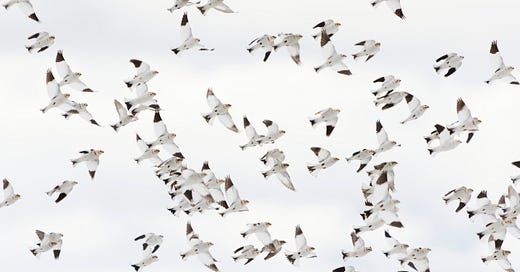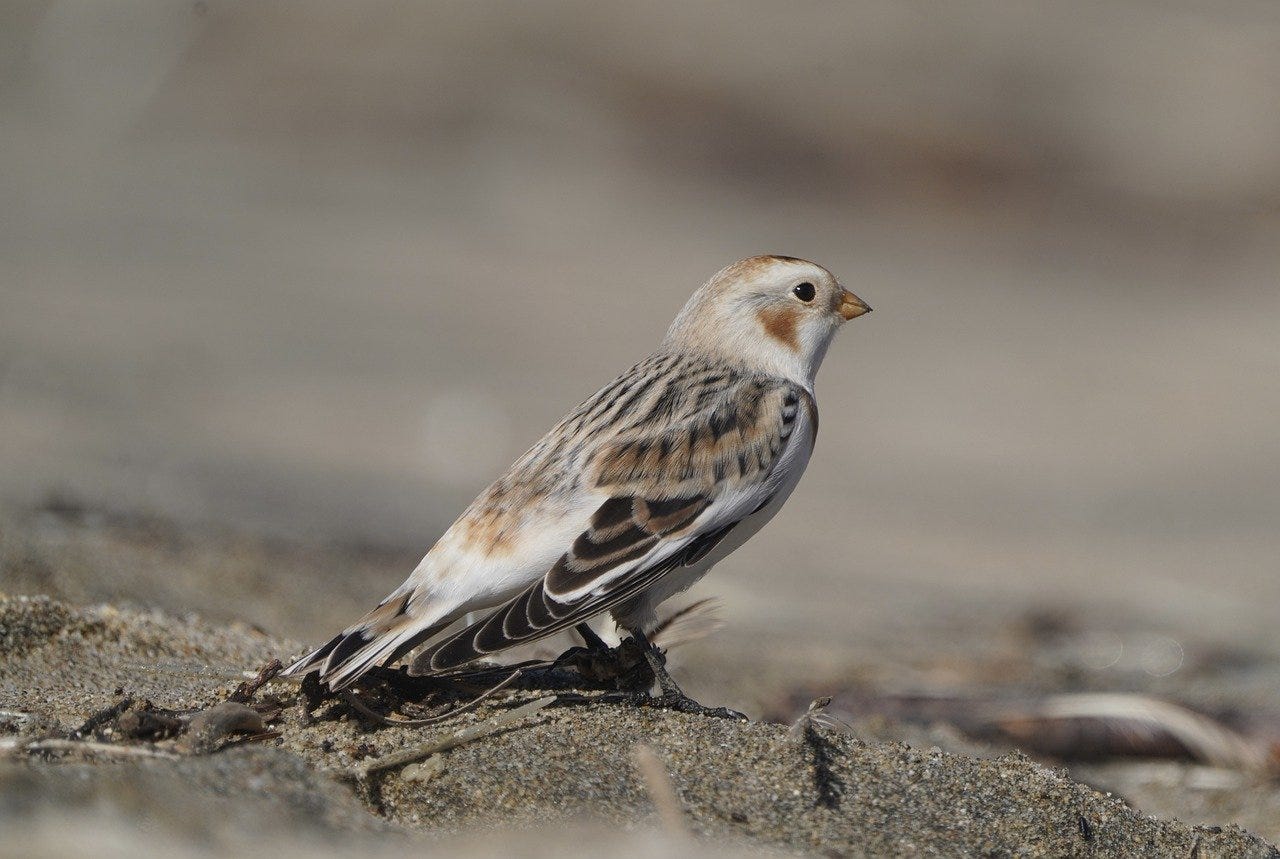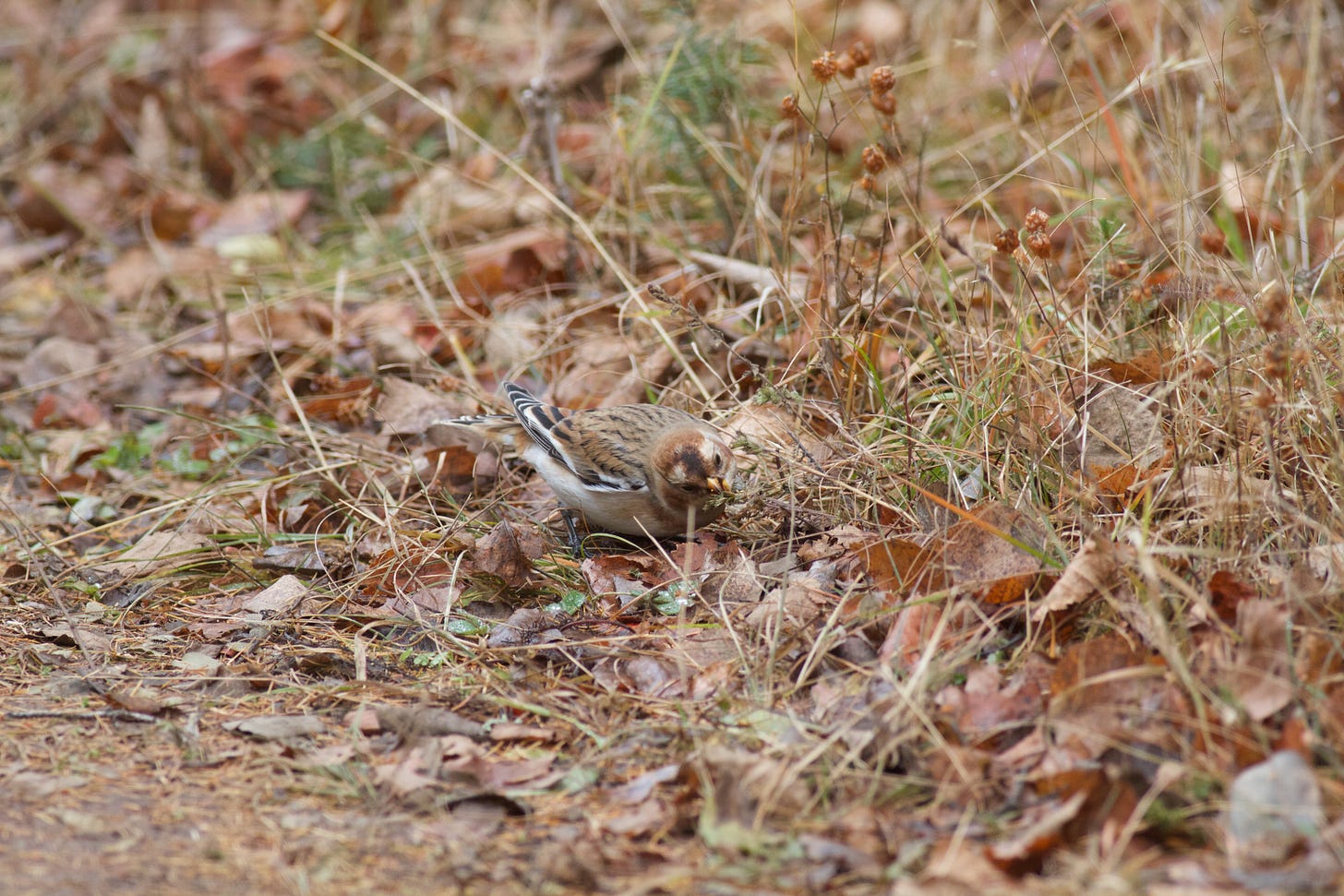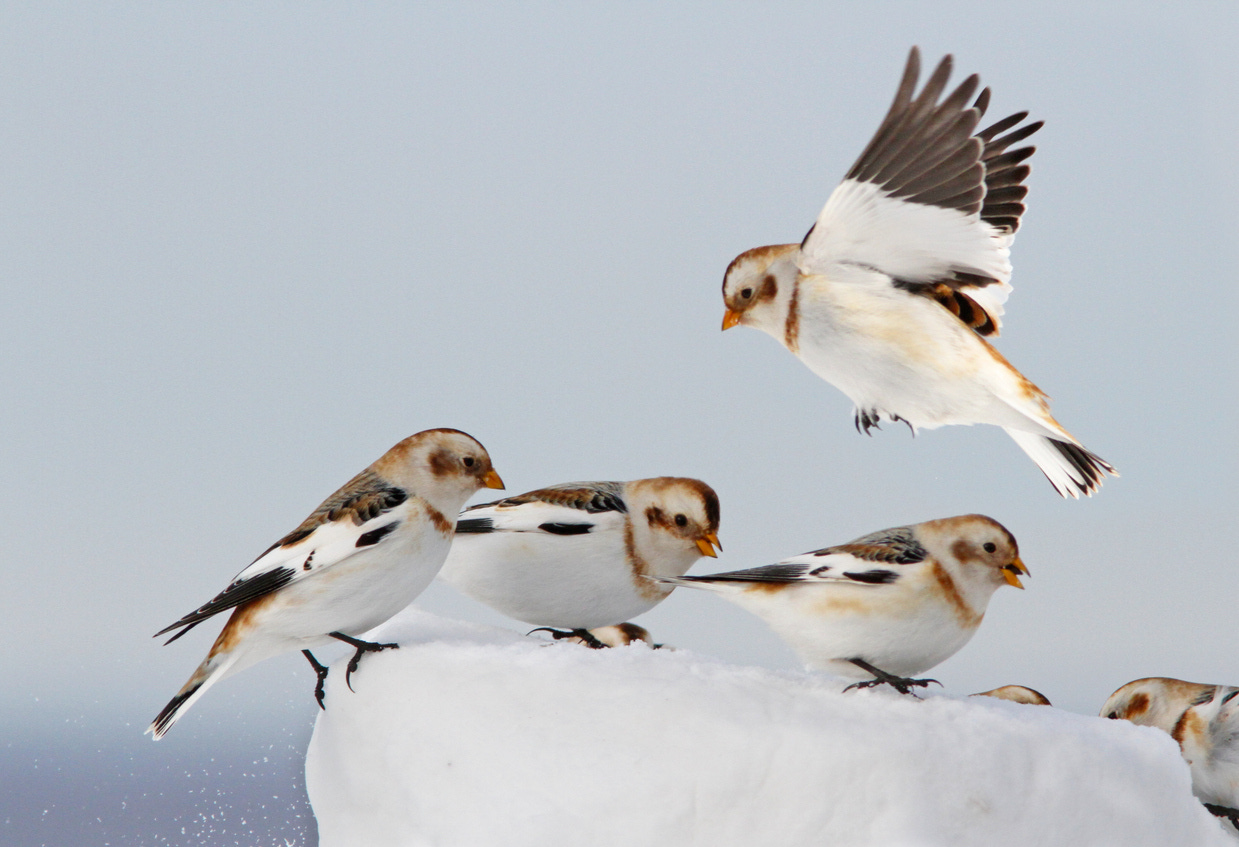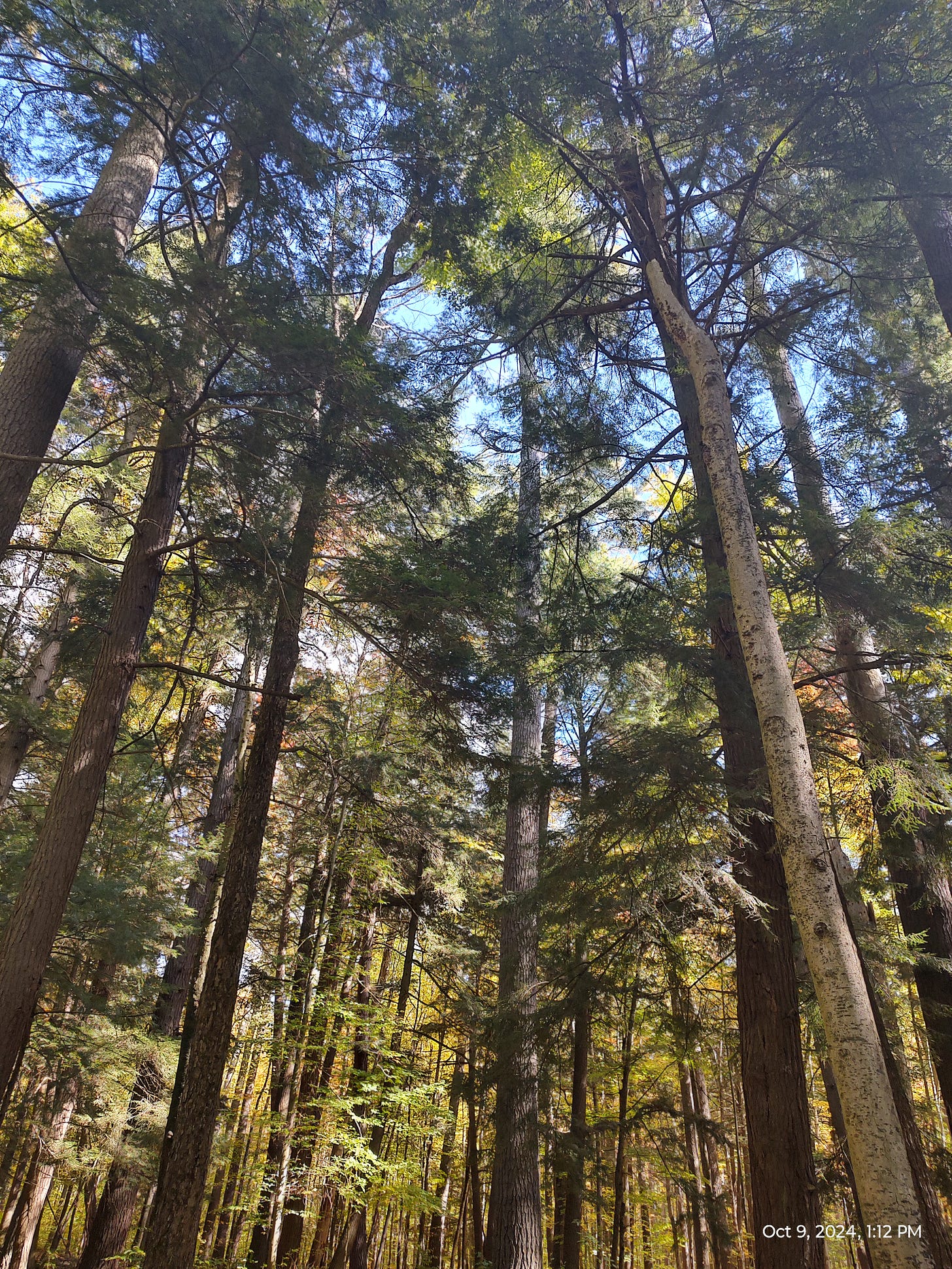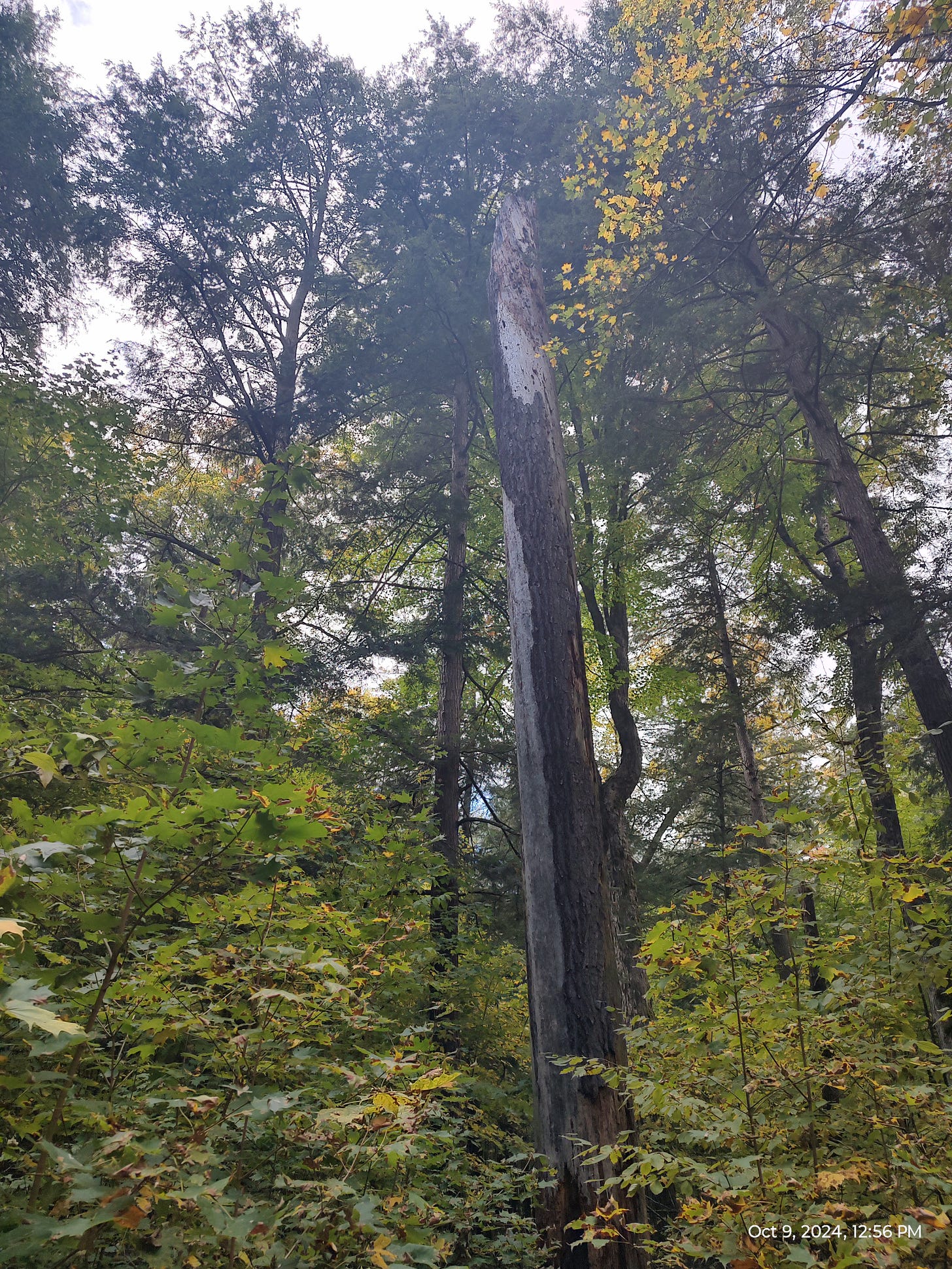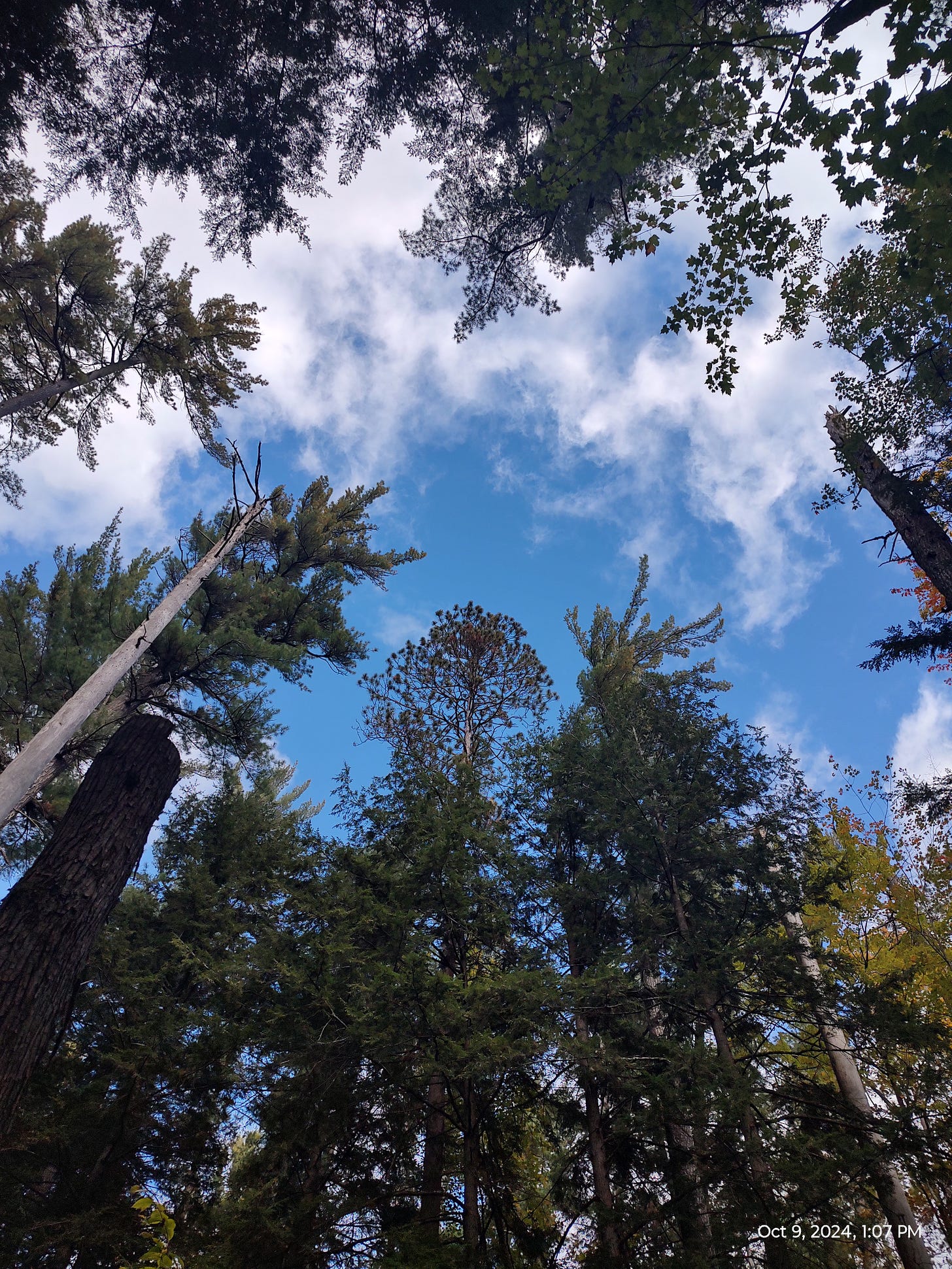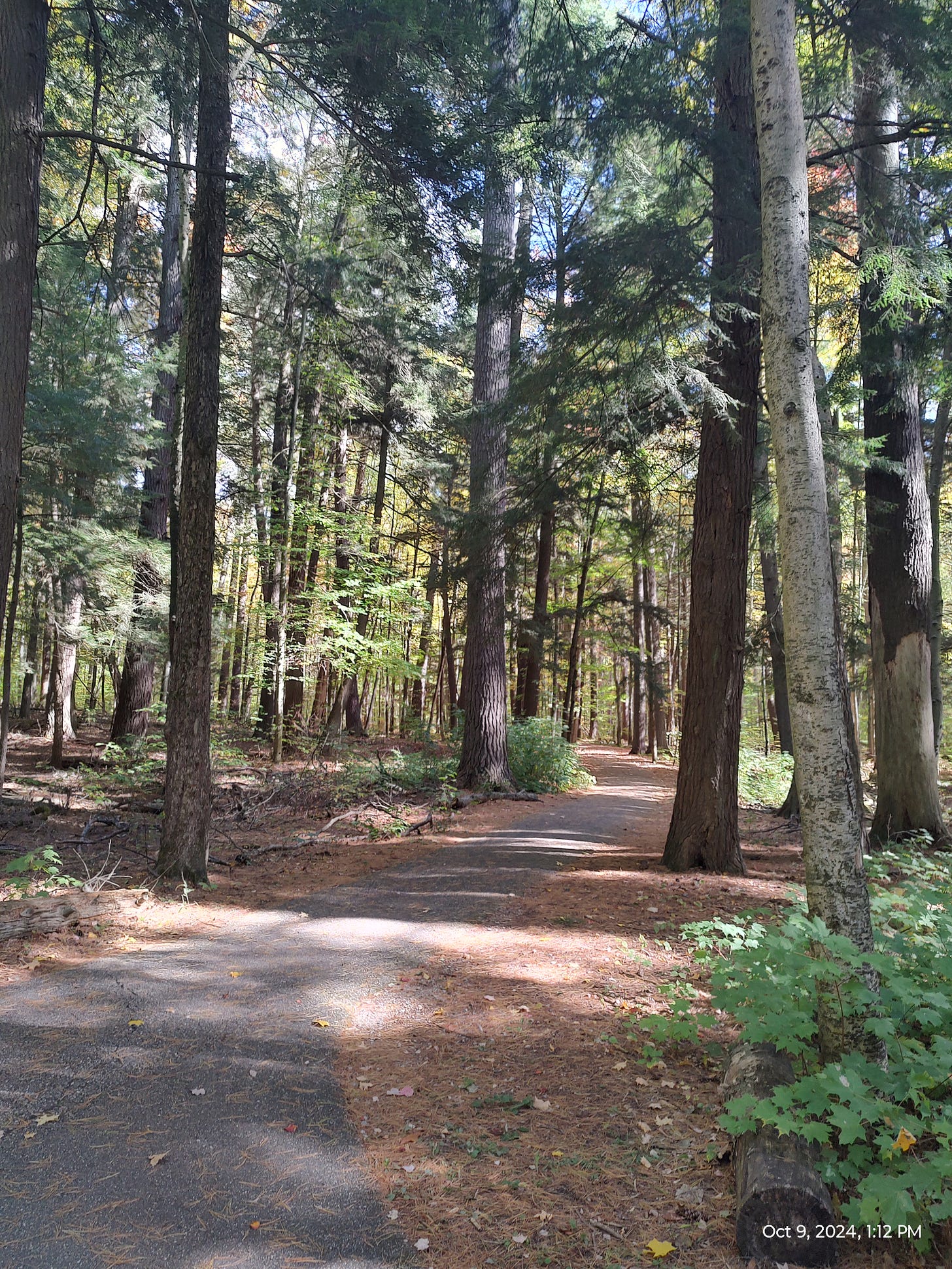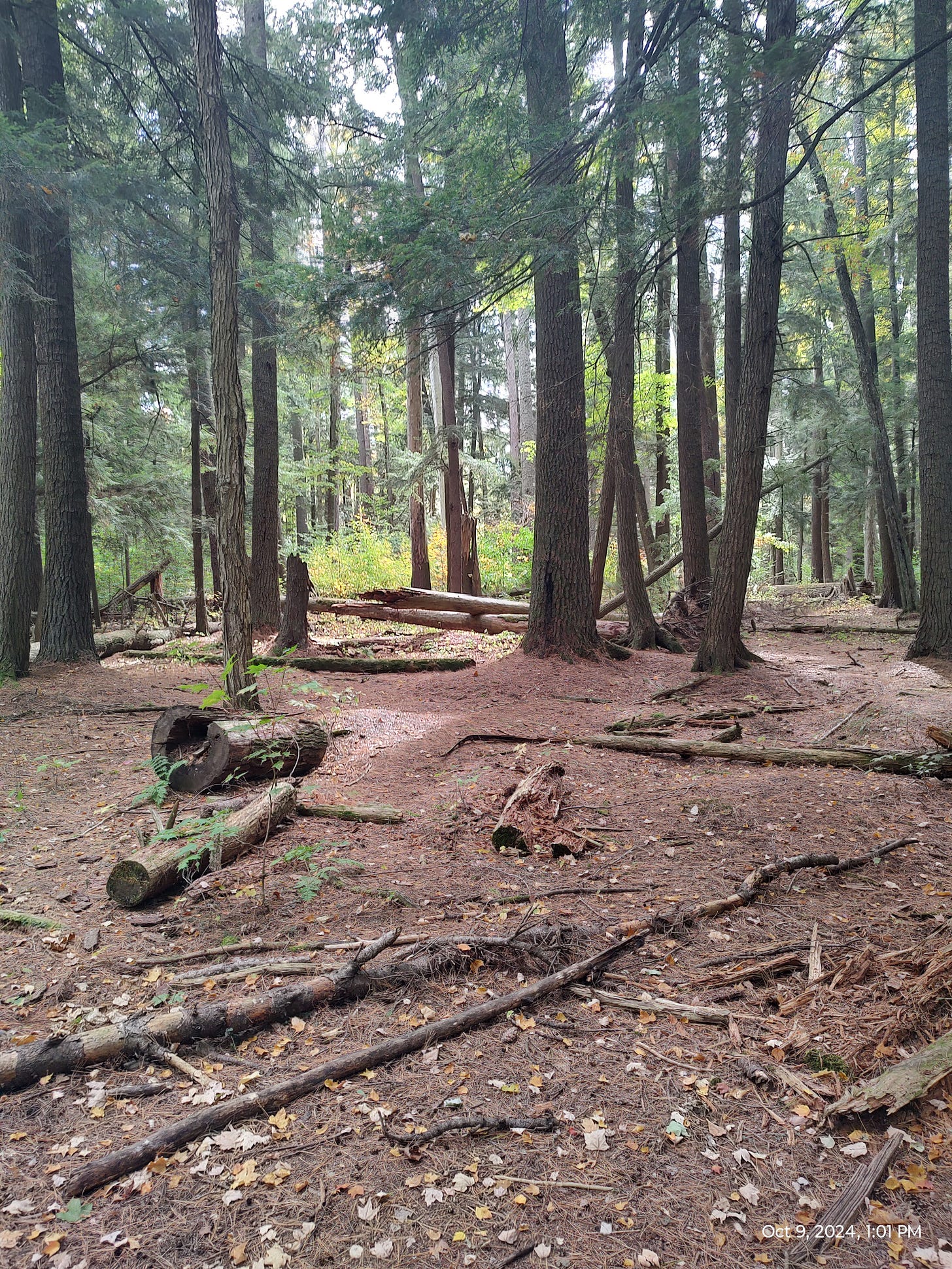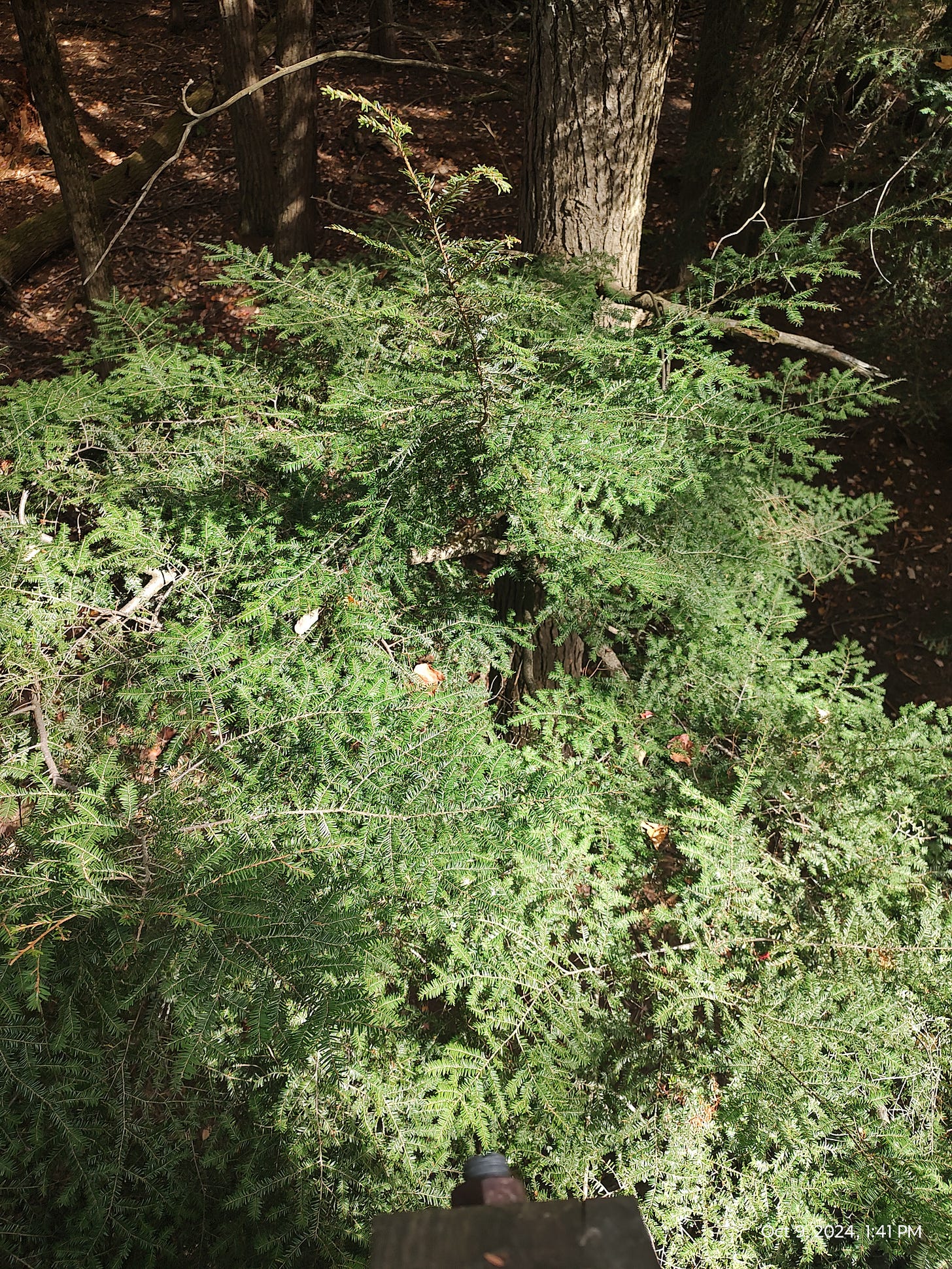The Northern Naturalist #8
Snow Buntings, Nature Study As a Step Back Toward Reality, Review: Hartwick Pines State Park, News and notes
Snow Buntings
During a long-ago Hawk Ridge Birdathon here in St Louis County, Minnesota, we ended up with difficult weather, especially for May: rain, sleet, periods of snow, temperature hovering around freezing, and most notably, high winds. The winds off Lake Superior were gale-force. Not for us the dreamy, balmy May weather of many birdathons, with flowers blooming, bees buzzing, and scented breezes.
We spent a fair amount of the day huddled in a fogged-up car, drinking formerly-hot coffee and grumbling. We did stay out birding though, and our daily total, while much lower than an average year, was pretty good. We birded along Minnesota Point in Duluth, a place almost guaranteed to give you ten or more species you won’t find elsewhere in this region. It’s a long sandbar; along with Wisconsin Point (separated only by an artificial ship canal), it’s the longest freshwater sandbar in the world.
We didn’t find much that day. The songbirds were hunkered down in vegetation, and the water birds were not moving around. At one of the last vantages along the road on the point, we made the valiant decision to walk over the berm toward Lake Superior and look for birds in the teeth of that wind. Binoculars and eye-glasses were drenched and blurry instantly, but we stood and looked for a bit anyway, when one of us noticed a bird on the beach below. It was a pure black-and-white male Snow Bunting, lying flat on the sand, head out of the wind. This is the plumage of high summer in the Arctic, and we don’t see it here much, but there it was, the prize of our day.
The reason we don’t see this prime breeding plumage much is that, for us, Snow Buntings are fall migrants. They are the most northerly-nesting songbird, and we don’t see them until mid-fall at the earliest. Then they still flash their broad, white wing panels when they fly, but their white is suffused with light cinnamon brown, and their backs have added streaky brown tones.
In late October, for birders and non-birders alike, Snow Buntings are an exhilarating sign of the approach of winter. They lurk in large flocks along roadsides, and when a car passes, the flock sweeps upward (some say “like snowflakes”). While the birds are on the ground, they blend in with the gravel and scant snow, and when they take flight, their white flashes prominently. They tend to stay low; sadly, many are hit by cars (although weather is still probably their worst migration obstacle.)
Snow Buntings will remain in our area for a few weeks. I say “remain,” but we don’t really know if it’s the same birds hanging around or new flocks arriving from the Arctic. They are headed toward the agricultural areas of the Great Plains. Here, a few may spend the whole winter, but some years they pass through completely. If you are searching for them in winter after there’s a snow cover, look for manured fields. The manure contains seeds, and its dark color warms up in the sun. Snow Buntings love it.
Snow Buntings sometimes associate with Horned Larks and Lapland Longspurs. Especially in these mixed flocks, they may be quite approachable; but they always seem restless and ready to take off. If you are lucky enough to get close, look for the straw-colored bill with a dark tip. The big white wing panels are always a good field mark (but of course many birds have some white in the wing).
Until recently, Snow Buntings were considered sparrows, but they and the other buntings have been moved to an entirely new taxonomical group based on genetic information. Like sparrows, they are ground-feeding seedeaters, although unlike sparrows, which spend a lot of time in bushes and trees, Snow Buntings are almost exclusively on the ground when not in flight. I have seen them perched on something, but it’s rare enough to draw comment when it happens. Many years ago, I was doing a migrant count at the old Lakewood Pumping Station when a Snow Bunting landed in a nearby bush. It looked so out-of-place that it took me a second to realize what it was.
Snow Buntings differ from other tundra songbirds in that they make their nests in rock crevices and cavities. This improves the survival rate of their eggs and young, but it creates a shortage of nesting spots. As a result, male Snow Buntings are the earliest songbirds to return to the Arctic as they strive to stake out the best nesting spots before the females arrive over a month later. The advantages of arriving early are counter-balanced by the greater danger of late winter storms. Once the females are on the nest, they don’t leave, and the males feed them. This keeps warmth on the eggs continuously, which is of course important during the frequent cold conditions where they nest.
While adults eat mostly (over 85%) seeds, the young are fed invertebrates exclusively. Snow Buntings hunt invertebrates by patrolling the edges of snow banks. When these melt, the newly-exposed ground may hold invertebrate larvae, which are mostly immobile due to the recent cold of the snow. If the snow banks expand again, their expansion will immobilize other larvae which, being cold-blooded, slow down in the advancing cold.
I have heard a few of them on Minnesota Point already this fall. Their full song, which we don’t hear here often, is complicated; here, they have a rattle call, similar to that of Lapland Longspurs but softer; and a sweet-toned tyuu note. Feeding flocks on the ground will make a raspy, soft nert call. If you pay attention, you can practice learning these sounds, all in one season, because so many come through.
Most of the Snow Buntings arrive after the leaves have dropped, the weather has cooled, and the days have become achingly short. They are birds of the tundra, and they bring us a little tundra mood too.
Nature Study as a Step Back Toward Reality
Life today fosters living in a digital, indoor, isolated bubble.
If one is in that bubble, it’s hard to thrive into sanity and health. It can be hard to step out of the bubble. The digital attractions and the ease of staying home are seductive.
Nature study can be a step out of the bubble, back toward real life. Perhaps “nature study” is too much a school term for you. What I mean is any kind of learning about the natural world: birding, gardening, butterflying, wondering at dragonflies, knowing the trees, finding wildflowers, meditating on moss, or any other natural realm.
The first benefit is that it gets you outdoors. You have a reason, and that helps you find the energy to get out.
Maybe you have to go outdoors for other reasons. Learning about nature will help you enjoy those times. Yesterday, I pulled up in front of a closed, undistinguished shop. In a crevice in the sidewalk in front, a goldenrod bloomed. It immediately caught my attention and gave me a little burst of interest.
You can begin at your level. Whether you’re a complete beginner or have some experience, your mind will be engaged at that sweet spot where some things are satisfyingly familiar, with enough novelty to keep you growing.
Nature study helps you regulate your dopamine. Dopamine is the brain chemical that gives you a good feeling when a reward is at hand. Much of digital life is optimized to get you bursts of dopamine. After repeated exposures, it becomes harder and harder to get that burst, and this leads to all sorts of odd feelings and behavior. The dopamine you get while you’re out birding, for example, comes at an irregular, slow pace. That in itself can be healing.
Learning something new, especially a new-to-you web of information, can exercise and sharpen your mind. The desire to press forward in this web gives the motivation to work the brain a bit.
In a short period of time, you can learn enough to not be the one-who-doesn’t-know—the one who mistakes a chickadee for a hummingbird, or a pine tree for a spruce tree.
Finally, getting out to learn about nature gives you the chance to witness miracles. In the tick-tock pattern of industrial human life, miracles are by definition something outside the normal pattern of things. In nature, miracles are all around us, but we need to notice them.
Pick an area that interests you a little. Get out and look for it. Buy a field guide (or read a naturalist’s newsletter!), find a friend who’s interested too, and take that step.
Old Growth Forest, Hartwick Pines State Park, Grayling, Michigan
Hartwick Pines State Park in Michigan contains a beautiful area of old growth forest.
Old-growth forest is woodland that has been left unlogged and mostly untouched, with little sign of human alteration.
According to a sign in the park, a logging company in the area ended its cutting due to a bank run that shut them down for three years. When they returned to logging, they went to a large parcel nearby, but never returned to the 86-acre stand now known as Hartwick Pines. Karen Hartwick purchased the land in 1927, kept it intact, and later gave it to the state. The Armistice Day storm of 1940 destroyed a large part of the stand, and today it’s 49 acres.
Hartwick Pines is a great place to experience what an old-growth forest feels like. There’s an easy, one-and-a-quarter mile trail through the woods; here you can experience some of the key characteristics of old-growth:
Big, Old Trees with Large Trunks:
This is the definitional criterion for old-growth. There are some impressively-large trees here. (That’s relative, of course—there are many larger trees in the world.)
Canopy Gaps:
When a single giant tree falls, it leaves a large opening in the canopy.
Relative Lack of Ground Cover:
The lack of light on the forest floor beneath this dense canopy makes for a lack of dense vegetation on the ground.
Coarse Woody Debris, With Pits and Mounds:
In old-growth, any limbs that fall are visible on the forest floor as they rot. Eventually, you can see pits and mounds that are the remains of tree trunks of long ago.
I love the feel of walking through old growth. Every so often, you come across a grizzled giant—a tree that is obviously much older than the smaller trees around it. I never tire of looking at trees like this. There are giant Yellow Birch in Jay Cooke State Park near where I live. At Hartwick, the giants are White Pine, Red Pine, Hemlock, and Beech.
Hartwick Pines is located near Grayling in Crawford County, about an hour south of the Mackinac Bridge. Most of the park (over 8,000 acres) is a beautiful forest, though not old-growth. We camped here long ago, a trip that is memorable for the Whip-Poor-Will that perched above our tent and sang all night long.
If you get the chance, it is well worth your time and effort to visit a patch of old-growth forest and feel what much of the woods was like before the age of logging.
News and Notes:
In an early draft of my review of Larry Weber’s Webwatching book, I had included a typo saying he wrote “mature-themed” books. Almost gave him a new career there, but I caught the typo, and he’s still writing “nature-themed” books.
Rarities on the North Shore of Lake Superior so far this October: Sabine’s Gull, Smith’s Longspur, Scissor-tailed Flycatcher, Sprague’s Pipit, plus Ross’s Goose, Short-eared Owl, Townsend’s Solitaire, Nelson’s Sparrow, and Surf and White-winged Scoters. It’s just getting started!

